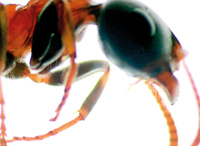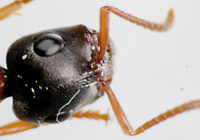News
Ant-bites could be fatal, don’t ignore its allergic reactions
Ant-bites have compelled a few people in areas of Panadura to seek medical treatment. However, only people allergic to these bites need medication, and there is no need to panic say experts.

Hathpolaya (c) Courtesy Medical Research Institute. and below head of Hathpolaya
Earlier this week, it was reported that several people in Horethuduwa, Panadura, sought medical treatment for ant-bites. Upon information received, Medical Research Institute (MRI) Director, Dr Anil Samaranayake dispatched a team to investigate the matter. He said samples of this particular ant responsible for the more-than-painful bites, has been collected and brought to the MRI lab for further investigations. These ants have strong jaws and their bite can bring upon allergic reactions to certain people, warns Dr Samaranayake. However, these ants bite only when agitated, and there is no need to panic, he added.
Investigating the images of the ant, Sri Lanka’s foremost ant expert – Kelaniya University’s Prof. Sriyani Dias, identified it as a ‘Hathpolaya’ (Tetraponera rufonigra). This ant usually lives in trees and hence is an arboreal ant. The Hathpolaya’s body has a bit of colour, and is also known as ‘Arboreal Bicoloured Ant’. It is a predator that lives on insects, and is larger than normal ants, growing up to 12-15mm, exceeding the size of a ‘kadiya’.
Prof. Dias also recalls a ‘Hathpolaya’ infestation in Matara, in 2010. Suddenly, from nowhere, these ants started to appear in several places. Investigations revealed that several large trees in the area had been felled, dispersing large ‘Hathpolaya’ colonies that had been ‘resident’ in these trees. The Panadura incident too could be for similar reasons, thinks the ant expert.
The number of Ant species found in Sri Lanka is subject to change, as scientists split new species into one and merge the existing species to single ones. According to the National Red List of 2012, Sri Lanka is home to 205 ant species. The ‘Hathpolaya’ is categorised under ‘Least Concerned’ which means it is not a threatened species.

In 2010, the Sunday Times reported the death of a woman due to a ‘Dala Kadiya’’-bite. But, can an ant’s bite be fatal?
Experts say people react to insect stings differently, where some develop allergies that could lead to severe conditions. “It is like certain people being subject to allergies reactions after consuming pineapple or prawns”. The age and how nourished/susceptible the body is due to other inadequacies within, are contributory factors to an allergy becoming fatal. “Otherwise, Sri Lanka’s ants are usually not the kind that cause fatalities. They don’t chase and attack when provoked, like bees or wasps,” insists Prof. Dias.
Symptoms of a serious allergic reaction, or anaphylaxis, include itching, hives, flushing of the skin, tingling or itching inside the mouth, hoarseness, swelling of the tongue or in your throat and narrowing of the airways which causes difficulty in breathing and swallowing, dizziness, fainting, and nausea or vomiting. can be fatal.
These types of reactions usually occur within minutes of the sting, but have been known to be delayed for up to 24 hours. If you are bitten by an ant and are subject to itching and hives or welts on the skin other than around the bite, seek expert medical attention immediately.
comments powered by Disqus
